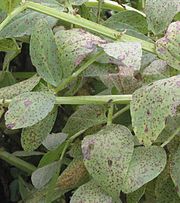Difference between revisions of "AY Honors/Fungi/Botryotinia"
From Pathfinder Wiki
m (+ translate tags) |
m (W126jep moved page Adventist Youth Honors Answer Book/Nature/Fungi/Botryotinia to AY Honors/Fungi/Botryotinia without leaving a redirect) |
||
| (One intermediate revision by the same user not shown) | |||
| Line 1: | Line 1: | ||
| − | <noinclude><translate></noinclude> | + | <noinclude><translate><!--T:1--> |
| + | </noinclude> | ||
[[Image:Tuinboon Chocoladevlekkenziekte.jpg|thumb|180px|Botrytis]] | [[Image:Tuinboon Chocoladevlekkenziekte.jpg|thumb|180px|Botrytis]] | ||
Botryotinia is a genus of ascomycete fungi causing several plant diseases. The anamorphs (asexual reproductive stage) of Botryotinia are mostly included in the imperfect fungi genus Botrytis. The genus contains 22 species and one hybrid. | Botryotinia is a genus of ascomycete fungi causing several plant diseases. The anamorphs (asexual reproductive stage) of Botryotinia are mostly included in the imperfect fungi genus Botrytis. The genus contains 22 species and one hybrid. | ||
| + | <!--T:2--> | ||
Plant diseases caused by Botryotinia species appear primarily as blossom blights and fruit rots but also as leaf spots and bulb rots in the field and in stored products. The fungi induce host-cell death resulting in progressive decay of infected plant tissue, whence they take nutrients. | Plant diseases caused by Botryotinia species appear primarily as blossom blights and fruit rots but also as leaf spots and bulb rots in the field and in stored products. The fungi induce host-cell death resulting in progressive decay of infected plant tissue, whence they take nutrients. | ||
<noinclude></translate></noinclude> | <noinclude></translate></noinclude> | ||
[[Category:Adventist Youth Honors Answer Book|{{SUBPAGENAME}}]] | [[Category:Adventist Youth Honors Answer Book|{{SUBPAGENAME}}]] | ||
Latest revision as of 14:13, 15 September 2021
Botryotinia is a genus of ascomycete fungi causing several plant diseases. The anamorphs (asexual reproductive stage) of Botryotinia are mostly included in the imperfect fungi genus Botrytis. The genus contains 22 species and one hybrid.
Plant diseases caused by Botryotinia species appear primarily as blossom blights and fruit rots but also as leaf spots and bulb rots in the field and in stored products. The fungi induce host-cell death resulting in progressive decay of infected plant tissue, whence they take nutrients.

